Understanding Wind Direction for Watersports Enthusiasts
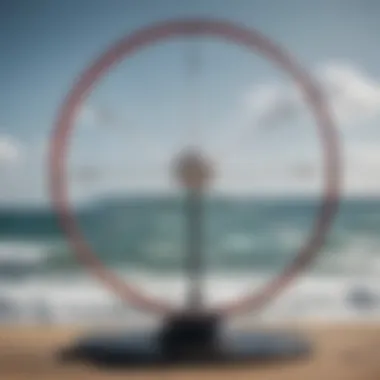
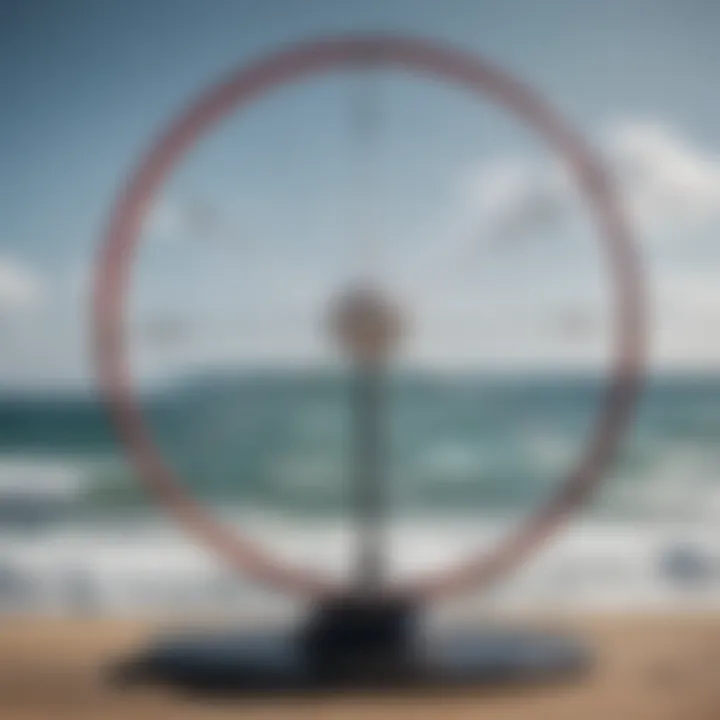
Intro
Wind direction is more than just meteorological detail; it plays a pivotal role in the realm of watersports. For those who ride the waves, sail across the sea, or paddle down rivers, understanding how wind interacts with water is crucial. It’s akin to a dance, where both elements must be in sync to ensure safety and enjoyment.
The ability to accurately gauge the wind's origin can mean the difference between a perfect day on the water or a troublesome outing. As we delve deeper into this topic, we will explore the science of wind patterns, learn essential techniques for novices, and uncover advanced skills that seasoned enthusiasts can adopt. We will also discuss the crucial gear that can make a real sea-change in your experience. This rich information aims to equip all who engage with the water, irrespective of skill level, to harness the power of wind while enhancing safety and performance.
The Importance of Wind Direction in Watersports
Understanding wind direction is absolutely crucial for anyone engaging in watersports. Not only does it affect how one navigates the open waters, but it also plays a pivotal role in safety, performance, and enjoyment. Before you head out with your sail, kayak, or surfboard, grasping the nuances of wind can make or break your experience. Wind direction determines the conditions under which you’ll be operating, influencing everything from water currents to the type of gear you’ll need.
Understanding Wind Basics
The way wind swirls around us isn't random; it has patterns that can be observed and predicted. From a practical standpoint, wind is simply the movement of air from high pressure to low pressure areas. These movements create invisible highways in the sky and across the water surface. This is where it pays to know the local geography and weather factors that contribute to specific wind patterns. For instance, during the summer months, coastal areas might experience steady sea breezes which are indeed beneficial for sailing. On the flip side, knowing that a strong offshore wind may mean rougher waves can save a novice surfer from unnecessary trouble.
Effects on Sailing and Navigation
When you're out on a sailboat, knowing how to read the wind can seem like second nature after a while, but it often takes practice. For sailors, wind not only propels the vessel but also challenges their skills. To harness the wind effectively, one must be aware of optimal sail angles, which direct the force right into the boat's sails for the perfect push forward. Adjusting sails for tacking and jibing techniques also directly correlates with wind direction. The margins are slim; a slight miscalculation can shift the whole sailing experience. Learning to find the angle and adjust accordingly ensures you glide across the water rather than fighting against it.
Wind Influence on Surfing Conditions
Surfing is another area where wind direction reigns supreme. The quality of the waves you ride doesn't just depend on swell size, but also the wind that shapes those waves. Waves generated by wind, often termed wind swell, can impact surf conditions significantly. If the wind is coming from the same direction as the waves, you're in for a bumpy ride. On the other hand, offshore winds tend to clean up and improve wave shape, offering the novice or seasoned surfer a clearer path to perfection. Timing and positioning in relation to wind currents can mean the difference between catching the perfect wave or getting wiped out.
"A good understanding of wind direction ensures that surfers can predict the best times and locations for riding waves, keeping the sport both enjoyable and safe."
Equipped with this foundational knowledge, water sports enthusiasts can elevate their craft and navigate the challenges presented by wind direction. Focusing on these aspects, whether sailing, kayaking, or surfing, is vital for every adventure on the water.
Determining Wind Direction
Understanding wind direction is crucial for watersport enthusiasts. Whether you're sailing, kayaking, or surfing, knowing where the wind is blowing from can mean the difference between a thrilling adventure and a risky situation. Wind direction influences the quality of waves, the speed of a sailboat, and even the safety of a kayak journey. By mastering the tools and methods to determine wind patterns, one can enhance their performance and ensure safety on the water.
Tools for Measuring Wind
Anemometers
Anemometers are devices that measure wind speed. They come in various forms, from handheld instruments to advanced digital versions. The key characteristic of an anemometer is its ability to provide accurate data about wind velocities, making it a valuable tool for watersport practitioners. For those aiming to optimize their performance based on wind speed, an anemometer is a popular choice in this article's context.
A unique feature of many anemometers is their capacity to record wind trends over time, offering insights into changing conditions. However, the downside is that some models can be expensive, limiting access for casual users.
Wind Vanes
Wind vanes, often seen atop buildings, indicate the direction of the wind. Their simplicity is a key attribute that makes them a beneficial choice for our discussion. A properly positioned wind vane allows users to quickly gauge which way the wind is coming. This can be particularly helpful for surfers and sailors who need to adjust their strategies instantly.
One unique feature of wind vanes is that they often function without batteries or complex setups. However, their primary limitation is that they do not provide quantitative measurements, which means users have to rely on additional tools for speed assessments.
Digital Weather Stations
Digital weather stations have become increasingly popular among watersport enthusiasts. They offer a comprehensive view of multiple weather conditions, including temperature, humidity, and of course, wind speed and direction. Their key characteristic is integration of technology, allowing users to get real-time data at their favorite water spots. Many users find this feature particularly appealing as it saves time and increases convenience.
However, the reliance on technology comes with disadvantages. Technical failures, poor connectivity, or battery issues can render these devices ineffective in urgent situations.
Using Natural Indicators
The Behavior of Trees
The way trees sway and move can offer significant clues about wind direction. A key characteristic of trees is their sensitivity to the wind, and observing them can guide a watersports enthusiast's decisions. For instance, if trees are bending towards the water, that suggests a strong wind blowing in their direction, indicating potential challenges for an outing.
One unique feature of using trees as wind indicators is their accessibility and low-cost nature, making them an excellent choice for everyone from beginners to seasoned pros. However, one must be cautious since the behavior of trees can sometimes be influenced by other factors like terrain or nearby structures.
Observing Water Surface
The surface of the water can provide significant information regarding wind conditions. When observing the water, notice any ripples or waves forming. This aspect is an advantageous way to judge wind speed visually - steeper waves usually indicate stronger winds. However, deciding on the right moment to assess the water surface is crucial.
Due to its visual nature, this method requires keen observation and a discerning eye. A downside is that it may not give precise measurements but can still serve as a good preliminary assessment.
Animal Movements
Animals, particularly birds and marine life, often exhibit behaviors that signal changes in wind direction. For example, seabirds flying low to the water can indicate strong winds, while fish jumping may suggest a disturbance in the surface brought about by rising winds.
This aspect of using animal movements is fascinating and indicates a connection with nature that might appeal to many watersport enthusiasts. However, relying solely on animal behavior might be misleading because other environmental factors also influence animal movements.
Compiling Data from Weather Apps
Features to Look Out For
When relying on weather apps, be mindful of the features they offer. Users should look for apps that present wind speeds and directions comprehensively, possibly in real-time. The ability to receive notifications about changing weather conditions is another key characteristic that enhances the user experience.
These features make weather apps a beneficial choice for recreational watersport participants since they can make informed decisions without needing multiple tools. However, user interface complexity can sometimes act as a barrier for less tech-savvy individuals.
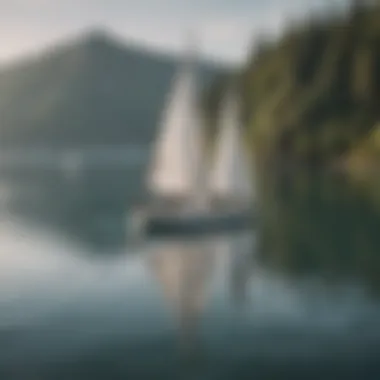

Reliability Checks
As there are many weather apps available, checking reliability is important. Look for apps that cite data sources, such as meteorological stations or satellite imagery. The key characteristic to note here is that trustworthy apps often provide a track record of accuracy that users can verify.
The reliability of the app dictates one’s confidence in planning watersport activities. Nonetheless, some apps can be misleading during sudden weather shifts or in less populated areas, making double-checking data crucial.
Real-time Updates
The availability of real-time updates is a significant advancement in weather technology. Apps that offer this feature allow users to track wind changes promptly, which is tremendously important for safety and performance. Their key characteristic lies in the immediacy of the information provided.
Real-time updates ensure that watersport enthusiasts can adapt swiftly to changing conditions, making them more beneficial for serious participants. Of course, one should consider battery life and data access when relying on such features, especially during extended outings.
Wind Patterns and Their Origins
Understanding wind patterns is crucial for watersports enthusiasts because they dictate not only the speed and direction of the wind but also the overall conditions on the water. Each type of wind, be it a gentle breeze or a strong gust, can drastically affect the safety, enjoyment, and performance of various activities like sailing, kayaking, or surfing. Recognizing how global and local influences manifest can improve decision-making, resulting in enhanced experiences on the water.
Global Wind Patterns
At a global scale, wind patterns are shaped by the Earth’s rotation and the uneven heating of the sun. The most well-known patterns include trade winds, westerlies, and polar easterlies. Each of these winds plays a unique role in the climate and weather systems.
- Trade Winds: Found near the Equator, they generally blow from east to west. The trade winds provide sailors with consistent breezes, ideal for long-distance sailing.
- Westerlies: These winds blow from west to east in the mid-latitudes. They can lead to unpredictable weather and are often associated with storms, creating challenges for both sailors and surfers.
- Polar Easterlies: These cold winds arise near the poles, and while they aren't prevalent for most watersports, their influence on global weather patterns can’t be ignored.
Understanding these patterns helps watersport enthusiasts anticipate weather changes and adjust their plans accordingly.
Local Wind Influences
While global patterns lay the groundwork, local wind influences can change the game significantly. These factors often depend on geographic features, urban settings, and the dynamics of bodies of water.
Geographic Features
Geographic features like mountains, valleys, and coastlines can dramatically alter wind behavior. On one hand, mountains can funnel winds, causing them to pick up speed and create challenges for some watersports. For instance, in regions like the Sierra Nevada, winds can hit the lakes at unpredictable angles, impacting kayakers and sailors. On the other hand, valleys may trap winds, resulting in relatively calm conditions that are favorable for a relaxed day of sailing.
The unique feature of geographic features is how they create microclimates. These localized conditions can result in the same area having different wind patterns from one spot to another, often turning a seemingly tranquil area into a wind-swept challenge.
Urban Areas
Urban environments intricately impact wind flow due to the presence of tall buildings and man-made structures. This can lead to wind channels that direct gusty winds in unexpected ways. For instance, cities nestled near large bodies of water often experience the phenomenon known as the urban heat island effect, where high temperatures lead to variations in local air pressure and ultimately influence wind direction.
The downtown areas may create what is commonly known as turbulence, resulting in shifting winds that could surprise a sailor or a surfer. It's crucial for enthusiasts to be aware of these factors, as winds can pick up speed and create dangerous conditions without much warning.
Body of Water Dynamics
The bodies of water themselves are not just passive observers; they actively participate in wind patterns. The temperature, depth, and size of a body of water can influence its wind dynamics significantly. For example, larger lakes often create their own weather patterns, generating localized winds that may be entirely different from those present just a few miles away.
One key characteristic is that warmer waters can heat the surrounding air, causing it to rise and leading to a replacement of cooler air from surrounding areas. This can generate winds that are favorable for sailing but potentially hazardous for other activities like diving, where calm surface conditions are often paramount for safety.
Finale
In this intricate dance of nature, understanding wind patterns and their origins remains pivotal for watersport enthusiasts. By recognizing the interplay between global and local influences, as well as factors like geographic features, urban settings, and body of water dynamics, one can ensure they are better prepared for the ever-changing conditions on the water.
Effects of Wind on Specific Watersports
Wind is often the unseen hand that can make or break your experience on the water. A true understanding of its nuances equips watersports enthusiasts with the tools to navigate, perform, and enjoy their chosen activities more effectively. Whether it’s the thrilling rush of sailing, the serene glide of kayaking, the adrenaline of surfing, or the exploratory depths of scuba diving, the wind directly impacts how each sporting endeavor unfolds. By dissecting how wind behaves in these different contexts, we can not only enhance our performance but also prioritize safety.
Sailing: Harnessing the Wind
Harnessing the wind in sailing isn't just about catching a breeze; it's about strategy and technique. Every sailor worth their salt knows that optimal sail angles can vastly change the game.
Optimal Sail Angles
Optimal sail angles refer to positioning the sails relative to the wind direction to maximize propulsion. Unlike simply angling a sail and hoping for the best, there’s a science to it, and getting it right translates to speed and effectiveness on the water. A key characteristic of this technique is that it can significantly improve your boat's performance—think of it as tuning an instrument before a performance. When the sails catch the wind at the perfect angle, it’s music in motion.
This approach allows sailors to tack more efficiently, cutting through the water with less effort. However, an unfortunate downside is that improper adjustments can lead to a decrease in speed or even danger if the wind shifts suddenly. Thus, understanding how to work with these sail angles is critical for both enjoyment and safety in sailing.
Tacking and Jibing Techniques
Then comes tacking and jibing, which might sound complicated, but they’re essentially maneuvering techniques to change direction while taking advantage of wind flow. Tacking is when the bow of the boat moves through the wind, while jibing is when the stern moves through the wind. This adaptability to wind direction is crucial, because sailing often requires navigating complex courses.

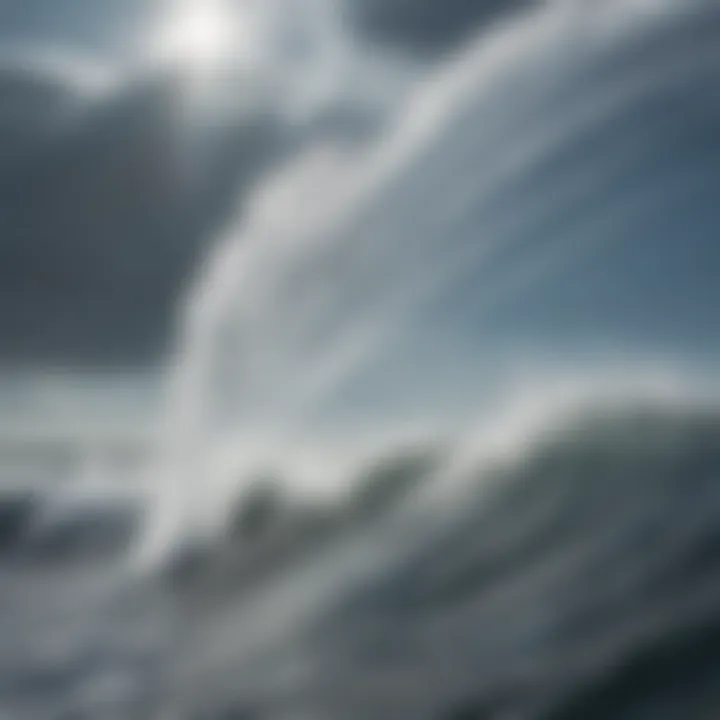
What makes these techniques widely adopted is their efficiency—properly executed, they keep a sailor’s momentum going, maintaining speed and control. Nevertheless, it requires practice, as misjudging a maneuver can lead to capsizing or loss of speed. Mastery over these techniques heeds closer ties with understanding wind behaviors.
Kayaking: Navigating Challenging Winds
For those who prefer kayaks, the wind can be both a friend and a foe. Being adept at navigating these waters means knowing how to handle challenges that strong winds can impose.
Stability Considerations
Stability is paramount in kayaking, especially in windy conditions. Understanding how wind interacts with your kayak can directly affect your performance. One unique feature of kayaks is their streamlined design, allowing for quick responses to shifts in wind. This design can help in making swift adjustments, which is essential when faced with unpredictable gusts that can have you swayed side to side.
However, the trade-off is that higher winds can make your kayak feel less stable. Understanding your boat’s limits, and how to work with—or against—the wind ensures a more enjoyable experience on the water.
Paddling Strategies
An effective paddling strategy can turn potential struggles into a smooth ride. Learning to adjust your stroke technique based on wind strength and direction can make all the difference. For instance, using shorter, faster strokes can help in countering the forces of wind while paddling into headwinds.
This adaptability is not just beneficial; it's vital for effective navigation. On the flip side, paddling against strong winds can be exhausting and may require greater endurance and technique refinement. Hence, knowing when to paddle is just as important as knowing how.
Surfing: Finding the Ideal Wave
When it comes to surfing, wind is a critical player in determining wave quality. It can either enhance or disrupt the conditions for riders seeking that perfect wave.
Wind Swell Basics
Understanding wind swell basics plays a significant role in surf planning. Wind swells are generated by local winds rather than distant storms, meaning they can create smaller, choppier waves. A key fact here is that surf conditions are highly variable based on the wind’s speed and direction, with offshore winds often producing cleaner, more rideable waves.
However, the unique nature of these swells can also mean that what may initially appear as ideal conditions can change in a heartbeat. Experienced surfers pay close attention to wind patterns—it's half the battle in finding the perfect spot to ride the waves effortlessly.
Timing and Positioning
Timing and positioning are equally crucial in securing a good wave. Knowing when to drop in on a wave can make or break your ride. Surfing with the wind at your back usually means you’ll catch waves more easily. A surfer geared up to utilize this knowledge brings their experience to a new level, riding with the wind in favorable positions.
Yet, if the timing is off, the consequences can lead to missed opportunities and even wipeouts. Thus, mastery in this aspect is essential for the best surf experience possible.
Scuba Diving: Understanding Surface Conditions
Unlike the other watersports where winds are most felt above the surface, in scuba diving, it’s more about understanding how wind impacts surface conditions, which can trickle down below the water.
Safety Protocols
Safety protocols during diving cannot be emphasized enough when wind affects water conditions. It’s crucial to have a good grasp of how wind creates waves and currents—this will fortify your diving plans and ensure a safe experience. Wind can whip up choppy surface conditions, making entry and exit from the water a challenge.
Thus, establishing clear safety protocols can help mitigate risks associated with sudden weather changes. Following guidelines, like monitoring weather forecasts and understanding local conditions, become second nature over time.
Site Selection
Lastly, site selection depends significantly on wind conditions. Divers need to pick sites with less current or waves caused by winds. A protected cove can offer a more serene diving experience, but poor judgment can lead to tumultuous dives that distract from appreciating underwater beauty.
Knowing where to dive relative to wind conditions ensures a better, safer experience, leading to greater enjoyment in the depths of the ocean.
Whatever your watersport of choice, understanding wind dynamics is crucial. It reinforces the age-old saying: "You can’t control the wind, but you can adjust your sails." Preparing for the whims of nature helps keep adventurers safe and satisfied in their aquatic pursuits.
Safety Considerations Related to Wind
Understanding wind conditions isn’t just about maximizing performance in watersports; it has a significant impact on safety as well. As much as enthusiasts thrive on the thrill of sailing, surfing, or kayaking, they must be aware of how wind can turn a leisurely activity into a risky endeavor. Recognizing hazardous wind patterns and being prepared for emergencies can mean the difference between a safe outing and a disastrous scenario.
Assessing Wind Conditions Before Activity
Recognizing Dangerous Levels
When it comes to engaging in watersports, recognizing dangerous wind levels is essential. High winds can create rough water surfaces, making conditions precarious for both the novice and seasoned athlete. Typically, wind speeds over 15 knots can start to raise eyebrows, depending on the specific activity. Not knowing these benchmarks could lead to underestimating the risks involved, which can be detrimental.
For instance, in sailing, strong winds can overpower small crafts that are not designed for high-speed conditions. It's always wise to consult local conditions or weather reports before heading out. Therefore, understanding and recognizing these dangerous levels ensures that anyone partaking has a clear sense of the boundaries they shouldn't cross.
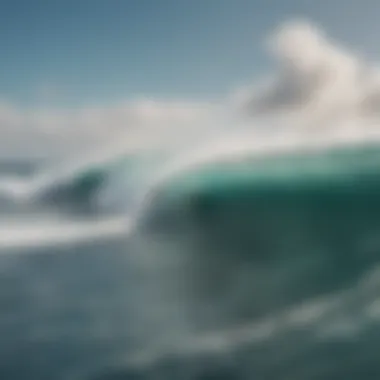
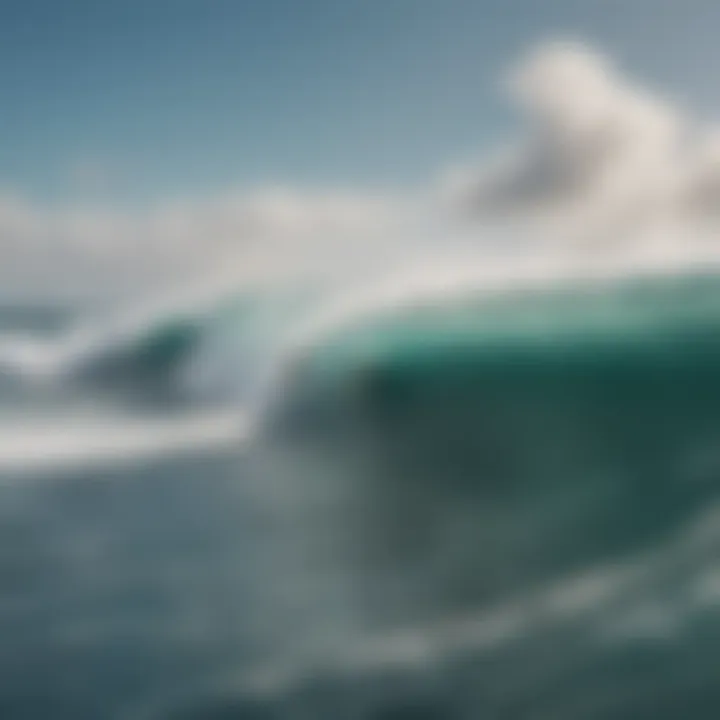
Here’s a key characteristic of recognizing dangerous levels: having multiple sources for weather data. This adds reliability and reinforces safety precautions, giving a more rounded outlook on what to expect. It’s not just about one gust of wind; rather, it’s about seeing patterns.
Understanding Wind Shifts
Wind shifts can be sneaky but deadly if not accurately tracked. Just as one prepares for an activity, a shift can catch them unprepared—resulting in a rapid change in conditions. A sudden shift can cause the direction of waves or even generate unexpected gusts that can capsize a kayak or make balancing on a surfboard more challenging. A practical understanding of these shifts can greatly influence the success of their venture.
A key feature here is the timing—acknowledging that shifts in wind can occur without much notice. Those familiar with the nuances of wind shifts have the advantage of adjusting their tactics promptly, which can be lifesaving in critical moments.
Emergency Preparedness
Gear Checklist
No outing is complete without a carefully considered gear checklist, especially when wind plays a crucial role. This checklist isn’t just a casual guideline but a vital tool for ensuring safety. It should encompass items like life jackets, weather radios, and any support tools specific to the chosen sport.
The main aspect of a gear checklist lies in thoroughness. An incomplete checklist may leave out gear that crucially impacts safety, like signaling devices or communication tools. The unique part of drafting your gear list is tailoring it to personal requirements as some may need additional safety equipment based on their experience level or chosen location. One size doesn’t fit all when it comes to safety.
Communication Plans
Setting up solid communication plans is often overlooked. Whether you’re with a group or venturing solo, keeping lines of communication open can be essential. Cell phones and walkie-talkies serve the primary purpose, but even simple hand signals can improve coordination during unexpected events.
The significant characteristic of a communication plan is its adaptability. Being able to adjust methods based on current conditions fosters an environment where risks can be mitigated. Moreover, teaching these techniques to all participants can ensure that everybody reacts efficiently under pressure. Not only does it build a safety net, but it also encourages camaraderie among those involved.
"Proper safety measures aren’t there to scare you; they’re there to empower your experience."
Incorporating these safety considerations can shape how enthusiasts engage with their watersport of choice. With a careful evaluation of wind conditions and sufficient preparation for emergencies, participants are more likely to enjoy their time on the water while keeping danger at bay. When water and wind dance together, a knowledgeable partner will turn the tide in favor of safety and enjoyment.
Tips for Optimizing Performance Based on Wind
Wind isn't just a minor detail or a background illustration when you're hitting the water; it’s a pivotal factor that can make or break your experience out there. Whether it's sailing, kayaking, or surfing, understanding how to adapt performance based on prevailing wind direction can significantly enhance your ability to navigate challenging situations, catch the best waves, or maintain a steady course. By adjusting tactics and selecting the right equipment, enthusiasts and professionals alike can maximize their enjoyment and safety.
Adjusting Tactics Depending on Wind Direction
Tactics can be as fluid as the watersports themselves; they must change with the wind, literally. For sailors, this means knowing when to tack or jibe based on the wind angle. A sailor venturing out with the wind at their back might choose a different route than one facing headwinds. Recognizing how different wind strengths influence maneuverability is crucial—greater wind speeds might require a tighter sail trim, while lighter winds often invite more flexible strategies.
For kayakers, adjusting to wind means not just bodily positioning but also strategic planning appropiately. If the wind is blowing towards a rough coastline, it might be wise to paddle diagonally to make steady progress. This concept is akin to walking against a strong gust; it requires more energy but leads to more controlled navigation.
In surfing, understanding the wind is essential for wave selection. An offshore wind, which blows from land to sea, often creates cleaner, more rideable waves. On the flip side, an onshore wind can turn smooth waves into choppy chaos. Surfers need to keep a keen eye on the wind conditions to choose the right time and spot to paddle out.
Selecting Appropriate Equipment
Sail Types
When it comes to sailing, the type of sail can profoundly impact performance. Different sails suit varying wind conditions; for example, a genoa, which is larger than a standard jib, captures a lot of wind but can be overwhelming in high winds. A key characteristic of these sails is their surface area—larger sails are great for lighter winds, whereas smaller sails are more suitable when wind speeds increase.
Choosing a sail might be a matter of personal preference, but considering the unique features—like batten systems that help maintain shape under varying wind conditions—can make all the difference. These features can provide an advantage during maneuvers, especially when wind force varies unexpectedly.
Kayak Designs
The design of a kayak greatly influences how it handles wind. For instance, touring kayaks, with their elongated hulls, are designed for stability and speed. A key characteristic here is the boat's width; wider kayaks tend to be more stable in choppy conditions. However, they may also be slower in straight-line progress, making them less ideal when speed's the order of the day.
Choosing the right kayak design based on your intended conditions is fundamental. Some kayaks come with adjustable rudders to help navigate through wind currents, which can be a significant asset when the wind attitude shifts unexpectedly.
Surfboard Shapes
Surfboards also come in a variety of shapes and sizes, each affecting performance in different wind conditions. A fish-shaped board, wider with a shorter length, is particularly effective in smaller waves but can lose control when faced with stronger gusts. Conversely, a more traditional shortboard offers better maneuverability in heavy winds and larger swells but requires a greater level of skill.
The uniqueness of each surfboard type contributes to either an advantage or disadvantage when dealing with wind. For instance, boards with more rocker—curvature from nose to tail—can handle choppier surfaces better, affording the rider increased control even when the wind is against them.
In summary, optimizing performance based on the wind involves a deliberate interplay of tactics and equipment specifically chosen for the conditions at hand. This foresight not only improves performance but also enhances the overall enjoyment of watersport activities, ensuring that each outing can be made as conducive to fun as possible.
Culmination: Integrating Wind Awareness into Watersport Practices
It's clear that a profound understanding of wind direction plays a pivotal role in enhancing overall watersport experiences. Whether you’re sailing, kayaking, or surfing, being attuned to the wind’s whims allows enthusiasts to make informed decisions, which can often be the thin line between a thrilling adventure and a hazardous situation. Integration of wind awareness into practice not only fosters safer outings but optimizes performance and elevates enjoyment.
Long-term Benefits of Understanding Wind
The long-term benefits of grasping wind dynamics extend well beyond immediate sailing skills or surfing success. Here are some key aspects:
- Enhanced Safety: Knowledge of wind patterns mitigates risks before heading out on the water. Consistent awareness of changing wind conditions can prevent even the most seasoned ones from being caught off guard.
- Improved Skills: As one develops a keen understanding of how wind affects their chosen sport, they begin refining their techniques. Sailors learn to harness every ounce of wind efficiently, kayakers adjust their strokes to ride the waves better, and surfers become adept in timing their runs.
- Informed Decisions: With a regular focus on wind direction, enthusiasts become adept at choosing the right days for their adventures. This means picking times when conditions are favorable, enhancing the probability of a successful outing.
- Greater Enjoyment: There’s an intrinsic satisfaction that comes from mastering one’s environment. Understanding wind dynamics ultimately enriches the entire watersport experience, making outings enjoyable and fulfilling.
“Wind is the invisible hand that guides our choices; to ignore it is like sailing blind.”
Moreover, integrating wind awareness cultivates a culture of respect for nature and its forces. Watersport practitioners become not just participants but also educated observers, recognizing the delicate balance within their aquatic environments.
In summary, embracing wind knowledge is not merely advantageous; it is essential for any serious watersport enthusiast. By blending this awareness into regular practices, the watersports community can ensure a safer, more proficient, and incredibly rewarding engagement with their activities.







